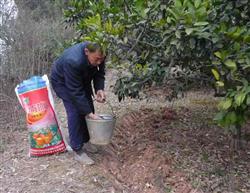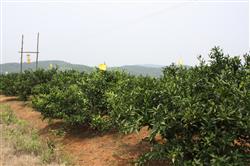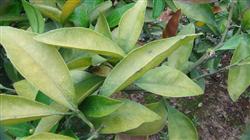What are the fertilization methods for growing oranges?

What are the fertilization methods for growing oranges? Please give an introduction to the following fertilization methods for citrus planting: (1) Root application: most of the citrus roots are distributed in the soil layer of the drip line on the outer edge of the crown, and the location of fertilization should be in the soil of the drip line outside the crown. The depth of fertilization is generally 20-40 cm. However, the depth varies with topography and fertilizer types, such as deeper fertilization in sloping land and shallow application in low-lying citrus orchards because of high groundwater level. The depth of soil manure, green manure and barnyard manure should be 30-40 cm, and the depth of chemical fertilizer should be 20 cm. When the humidity of citrus orchard soil is high, chemical fertilizer can be sprinkled and then turned into the soil. If the depth of fertilization in citrus orchards with low-lying terrain and high groundwater level is more than 60 cm, not only the roots can not absorb fertilizer, but sometimes there will be rotten roots. The ways of root fertilization include ring ditch application, strip ditch application, radial ditch application, hole application, whole garden fertilization, drilling fertilization and so on. Ring ditch application: dig a 20-40 cm wide and 15-45 cm deep ring ditch around the crown, and then apply a mixture of topsoil and base fertilizer, which is suitable for young citrus orchards. Strip trench application: dig 1-2 long trenches 50 cm wide and 40-50 cm deep between rows of citrus orchards, and then fertilize and cover soil. This method is suitable for rectangular grown citrus orchards. You can also dig several strip ditches between rows or plants that are about 20 cm wide and 15-30 cm deep, which are slightly longer than the crown width to fertilize. Radial trench application: dig 5-6 radial trenches 1 meter away from the trunk, 30-50 cm wide and 15-40 cm deep, reaching the outer edge of the crown. Fertilizer is applied to cover the soil in the ditch, this method is suitable for adult citrus orchards, especially for citrus orchards with narrow terraces. Hole application: under the canopy 1 meter away from the trunk, evenly dig 10-20 tapered holes with a depth of 40-50 cm, the upper mouth diameter of 25-30 cm, and the bottom diameter of 5-10 cm. Fill the hole with subtilis, cover the mouth with film, and apply fertilizer and water in the hole. This method is suitable for sandy citrus orchards with poor fertilizer and water retention. Hole fertilization: that is, under the tree crown, drill the soil hole with a soil drill, dilute the fertilizer into the hole eye, and let the fertilizer and water seep slowly. This method is used for densely planted citrus orchards and adult citrus orchards in less Rain Water areas. Fertilizing the whole garden: spread the fertilizer evenly over the whole garden, and then plough the fertilizer into the soil, with a depth of about 20 cm. This method is suitable for adult citrus orchards or dense planting orchards with dense roots throughout the garden. (2) the number of foliar spraying depends on tree strength and lack of nutrients. Young trees, strong trees or trees with less fruit can be sprayed less, while trees with more flowers and fruits should be sprayed more. It is better to spray in cloudy days or in the morning and evening, not in hot noon and rainy days. If citrus crops have the following conditions, foliar spraying should be carried out in time: (1) when there is a deficiency in the leaves. Targeted spraying of foliar fertilizer can alleviate the symptoms of element deficiency in time, which is better than soil topdressing and high utilization rate. (2) when the absorptive capacity of citrus roots is senescent. In the later stage of growth, the root activity often declines and the fertilizer absorption capacity decreases. At this time, it is appropriate to choose foliar fertilizer spraying. If the foliar fertilizer containing phosphorus and potassium is sprayed in the late growth stage, the yield can be increased. For citrus trees with calcium deficiency in the later stage, calcium foliar fertilizer should be sprayed 8 weeks before fruit harvest and sprayed 4 times at intervals of one week. (3) when the growth of citrus is affected by adverse environment. When the environment is disadvantageous to the growth of citrus, such as too much or too little water, drought, and the soil is too acidic or too alkaline, the absorption of nutrients by citrus roots is hindered. In order to restore growth quickly, if the method of root application can not meet the needs of crops in time, only foliar fertilizer spraying can quickly supplement nutrition and meet the needs of citrus growth and development. (4) when soil fertilization is difficult to operate. Under the condition that the amount of base fertilizer is insufficient and it is difficult to use soil topdressing, foliar fertilizer should be selected to supplement nutrient needs. Click to get more citrus planting techniques click to get more fruit planting techniques
- Prev

How to manage growing oranges in summer?
How to manage growing oranges in summer? Please introduce the management of planting citrus in summer with reference to the following methods: first, with high temperature in summer and more Rain Water, citrus is easy to produce a large number of summer shoots, consume a lot of nutrients, aggravate the second physiological fruit drop, and allow the summer shoots to grow. may cause a serious reduction in yield.
- Next

What is magnesium deficiency in citrus? How to fix it?
What is magnesium deficiency in citrus? How to fix it? Please give guidance on the occurrence of magnesium deficiency in citrus all the year round, but it occurs most frequently in late summer or autumn when the fruit is about to mature, and the old leaves and leaves near the fruit first show obvious symptoms of magnesium deficiency. This is because magnesium in older organs and tissues tends to shift when magnesium is deficient in oranges.
Related
- Moge, come on! The staff of the peasant association in the producing area of cantaloupe were frightened when the crowd gathered.
- Causes and Solutions of low Fruit setting rate of Apple
- Symptoms and control measures of passion fruit virus disease
- Fruit growing lesson: how do apple orchards keep high yields?
- Can you build orchards in the mountains? What are the pros and cons?
- How to manage the coloring period of Crisson grape?
- This paper introduces the processing technology of two kinds of fig products.
- How much is a month for retired teachers in rural areas by 2020?
- How can strawberry planting increase sugar content? We should pay attention to management in many aspects.
- What are the cultivation techniques on how to improve the yield of golden fruit?

